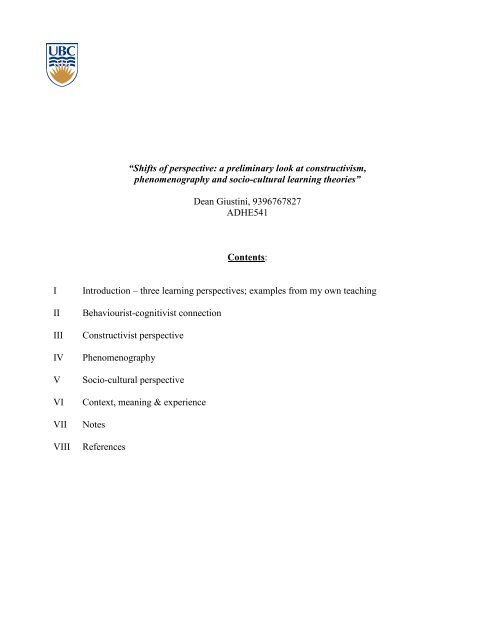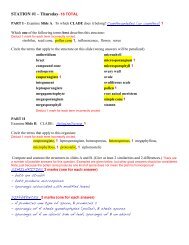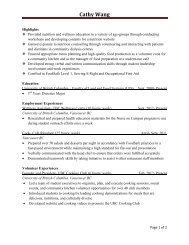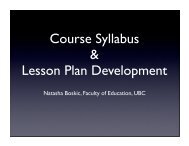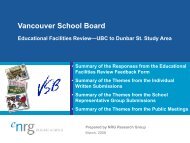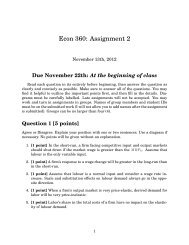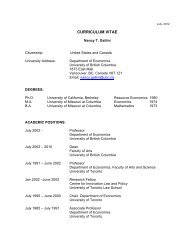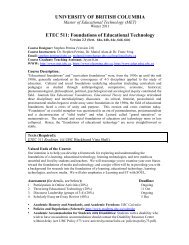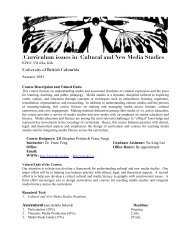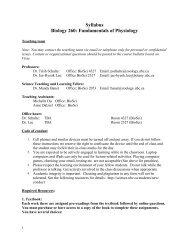adult learning theories - UBC Blogs - University of British Columbia
adult learning theories - UBC Blogs - University of British Columbia
adult learning theories - UBC Blogs - University of British Columbia
- No tags were found...
You also want an ePaper? Increase the reach of your titles
YUMPU automatically turns print PDFs into web optimized ePapers that Google loves.
“Shifts <strong>of</strong> perspective: a preliminary look at constructivism,phenomenography and socio-cultural <strong>learning</strong> <strong>theories</strong>”Dean Giustini, 9396767827ADHE541Contents:IIIIIIIVVVIVIIVIIIIntroduction – three <strong>learning</strong> perspectives; examples from my own teachingBehaviourist-cognitivist connectionConstructivist perspectivePhenomenographySocio-cultural perspectiveContext, meaning & experienceNotesReferences
IntroductionThis paper discusses cognitivism-constructivism, phenomenography and socio-cultural <strong>learning</strong> –three <strong>learning</strong> perspectives that share common aspects, but diverge in important ways. It argues thatall three <strong>theories</strong> engage students similarly, but ultimately do so distinctly. The author draws on hisown experience in teaching student librarians in order to highlight various social themes runningthrough the three <strong>theories</strong>. The paper is followed by a brief exploration <strong>of</strong> the context, meaning andexperience <strong>of</strong> the three perspectives. (1)The behaviourist-cognitivist connectionThe behaviourist-cognitivist connection can be viewed historically. The rise <strong>of</strong> cognitivism was areaction against early 20 th century behaviourists Pavlov, Thorndike, Watson (1936) and laterclassical conditioning theorists (Skinner, 1938). In keeping with the behaviourist tradition, theCanadian social-cognitivist Bandura and his disciple Walters (1963) affirmed that children need toperform and receive reinforcement for <strong>learning</strong> to take place, but observed that some behaviors aremodeled simply by observing other individuals.Cognitive theorists know that much <strong>learning</strong> takes the familiar stimulus-response and positivereinforcement pattern, but emphasize that “positive feedback about the correctness <strong>of</strong> something ismore important than its role as a motivator” (Good & Brophy, 1990, pg 187). This distinctionunderscores the teacher’s role in cognitivism, especially in terms <strong>of</strong> providing feedback andreinforcement at critical times to encourage student motivation.Cognitivists emphasize the importance <strong>of</strong> active engagement with the surrounding world (Vrasidas,2001) and creating schema (or patterns) where information can be processed and stored (Good &Brophy, 1990). Later, the so-called schema can be used for efficient retrieval as new information ispresented, particularly as the learner negotiates deeper layers <strong>of</strong> complexity in his <strong>learning</strong>.Cognitivist-constructivist".. cognitive theorists view <strong>learning</strong> as involving the acquisition or reorganization <strong>of</strong> thecognitive structures through which humans process and store information." (Good &Brophy, 1990, pg 187).- 1 -
In the cognitivist-constructivist perspective, knowledge is constructed (Vygotsky (1978), Bruner(1996), not transmitted. Knowledge is constructed by the learner, through a prism <strong>of</strong> his ownexperience. This bank <strong>of</strong> experience – also, mental structures or schema – forms the basis <strong>of</strong>cognitivism. The learner’s prior knowledge-building and meaning-making is <strong>of</strong> primary importanceto constructivists, referred to as the contextual framework (Ertmer & Newby, 1993). In this set <strong>of</strong><strong>theories</strong> (2), knowledge results from individual constructions <strong>of</strong> reality (Eggen, 2001). When realityis constructed meaningfully, learners increase the likelihood <strong>of</strong> building knowledge.As teachers know, most <strong>learning</strong> involves some struggle, even cognitive dissonance. Piaget (1973)believed that a state <strong>of</strong> disequilibrium was created when learners were presented with informationconflicting with their existing schema. To resolve this, information is either adapted to the newsituation (accommodation) where schema are modified, or new experiences are incorporated(assimilated) in some way into the framework (Eggen, 2001).The instability engendered by disequilibrium occurs at various points temporally, and seeks to findresolution. This occurs in my students, especially at the start <strong>of</strong> term when things are new, andchaotic. New information is a stimulus for <strong>learning</strong>, which is why a new class <strong>of</strong> learners seems s<strong>of</strong>ull <strong>of</strong> promise. But a learner’s ability to accommodate or assimilate new information is notspontaneous; I find that students take responsibility for their own assimilated knowledge when Ihelp to engage them. One way to promote this is by designing <strong>learning</strong> projects according to theneeds <strong>of</strong> employers; the in-class exercises I design must be grounded in that reality somehow.Vygotsky put a great emphasis on how knowledge is transmitted through culture and language(Eggen, 2001). His interest in the cultural aspects <strong>of</strong> <strong>learning</strong> led him to his theory <strong>of</strong> the “zone <strong>of</strong>proximal development” which refers to “tasks that a child cannot do alone but can accomplishwhen assisted by a skilled partner” (Eggen, 2001). Often, with my students, I feel that I am less anadjunct instructor than a skilled partner or colleague in the <strong>learning</strong> enterprise.As suggested, the design <strong>of</strong> collaborative, team-based activities must be rooted in reality (Doolittle,1999; Fosnot, 1992). I try to design in-class exercises that promote the social and help students tomonitor, evaluate and update their own understanding. I encourage my students to negotiate theirunderstanding <strong>of</strong> concepts by anchoring them in real contexts, and presenting them to theircolleagues in cognitively different ways.- 2 -
If something has meaning, learners will remember it (Hounsell, 2005). During term, I bring studentlibrarians face-to-face with actual patients; I select complex problems and encourage discourse as ameans <strong>of</strong> rendering meaning. What information needs do patients express? What do you do whenvery ill patients (or families) get emotional? These questions foster cognitive apprenticeship,collaborative <strong>learning</strong> and social negotiation <strong>of</strong> ambiguity, all aspects <strong>of</strong> the perspective.These pedagogical techniques emphasize that meaning-making is created through participation insocially, culturally, historically and politically-situated contexts (Vygotsky 1978). The criticalaspect is participation in the social, especially dialogue with other learners. Through collaborativedecision-making, learners take steps to support meaning-making, and encourage that in others.The phenomenographicPhenomenography is the empirical study <strong>of</strong> the differing ways in which people experience,perceive, apprehend, understand and conceptualize various phenomena (Marton, 1994). It “aims atdescription, analysis and understanding <strong>of</strong> experience” and is “directed towards experientialdescription”. Another way <strong>of</strong> describing it – <strong>of</strong>fered by a fellow student on the ALGC bulletinboard – is “constructing understanding <strong>of</strong> a phenomenon by differentiating it from its context”. (3)Phenomenography is related to radical and social constructivism in that all three assert that peopleperceive reality subjectively. Contrasted with the heterogeneity <strong>of</strong> constructivism,phenomenography is a homogenous perspective, and differs further by emphasizing the qualitative.As such, phenomenography is not a body <strong>of</strong> <strong>theories</strong> but a conceptual framework used tounderstand <strong>learning</strong> (Giorgi, 1999). Phenomenographers resist homogeneity as a label and believethat phenomenography is a “still developing, socially and historically constituted tradition ineducational research” (Ekeblad, 1997).Tesch (1990) groups this theory within an envelope <strong>of</strong> methodologies striving to discern differenceor patterns (variations) and commonalities among learners. “Discernment is at the core <strong>of</strong> our ways<strong>of</strong> experiencing the world around us… the discernment <strong>of</strong> variation or the experience <strong>of</strong> difference”(Marton, 1999).In my training as a librarian, I am accustomed to discerning information needs. Referenceinterviews illustrate what physicians need to solve their cases. Over the years, as the complexities- 3 -
<strong>of</strong> physician needs slowly revealed themselves to me, I learned how to discern variations, and howto interpret them for different clinical audiences, and contexts. “Individuals experience differentvariations <strong>of</strong> a phenomenon, learn to interpret the variations and place them in a context that isimportant to discern” (Marton, 1999). As so many <strong>of</strong> these patterns play out on a regular basis inmy practice, I equate my ability to discern what library clients need with my own intuitive sense,which is like a sixth sense never far removed from my decision-making process.Phenomenography should not be confused with phenomenology, although both aim to revealexperience as the object <strong>of</strong> research. Phenomenography concerns itself less with individualexperiences <strong>of</strong> reality and meaning than about the aggregated, collective experience, anotherdistinguishing characteristic. I am especially interested in perception as it pertains to blogging, andplan to do a phenomenographic or phenomenological analysis <strong>of</strong> my students’ perceptions <strong>of</strong> theact <strong>of</strong> self-negotiation in digital spaces during my sabbatical year.Phenomenology is associated with the identification <strong>of</strong> two opposing approaches: deep and surface<strong>learning</strong> (Marton, 1994, Entwistle & Svennson, 1997). A deep approach is an attempt tounderstand ideas beyond the textual, to reveal ideas sub rosa and to connect them to priorknowledge. A surface approach is concerned with reading the text, perhaps memorizing passages -but not going further. (The deep-surface metaphor <strong>of</strong> <strong>learning</strong> is also applicable to the behaviouristconstructivistdichotomy, incidentally.) I have found deep and surface approaches relevant inteaching. Teachers discern clues about how and what is learned from their students; especially howthey feel about what they are <strong>learning</strong>. By speaking to them, a number <strong>of</strong> qualitatively differentways <strong>of</strong> understanding the world may be identified (Marton, 1994).Socio-cultural <strong>learning</strong>Socio-cultural <strong>learning</strong> is situated with real-life actors and situations. Situated <strong>learning</strong> gives thestudent an opportunity to learn and create meaning from his personal experiences (via thought andaction, and language and culture) in ‘real life’ organizations (Brown, 1989). The knowledgeorganized by this perspective is linked to its context, via interaction with peers, as with socialconstructivism. As such, experience determines the <strong>learning</strong> structure rather than the teacher, whodoes not direct content formation.- 4 -
Lave (1997) and Wenger (1998) say that socio-cultural <strong>learning</strong> gives primacy to the dynamics <strong>of</strong>everyday existence; it also addresses the creative and interactive. According to Wenger (1998),human engagement with the world is “a process <strong>of</strong> negotiated meaning. The experience …is notproduced out <strong>of</strong> thin air" (Wenger, 1998). Wenger describes the “negotiation <strong>of</strong> meaning” as howwe experience the world and engage with it.In his model, negotiation consists <strong>of</strong> two interrelated concepts: reification which is central to everypractice, and involves turning abstract notions into congealed form; and participation whichrequires active involvement in social processes. Take, for example, the singer who wants to learnhow to be a successful choral singer. Put that singer in a choral milieu. By singing music <strong>of</strong>increasing complexity, and breathing synchronously with other singers and conductors, the realactivity <strong>of</strong> singing creates a situated experience that singing alone would never provide.For a number <strong>of</strong> years, I have felt intuitively that the best <strong>learning</strong> takes place within a pr<strong>of</strong>essionalmilieu, in the library – in situ. To that end, I recommend practical experiences and apprenticeshipsin libraries to reify in congealed form that which has been abstract (Wenger, 1998). Bringinglibrarians and physicians together is a powerful way to situate <strong>learning</strong>, to motivate and createmeaning for students as they build their experience interacting in real situations.Lave (1997) and Wenger (1998) say that socio-cultural <strong>learning</strong> gives primacy to the dynamics <strong>of</strong>everyday existence; it also addresses the creative and interactive in learners. Despite a familiarenvelope <strong>of</strong> experience, learners reinterpret, re-engage and re-cycle their understanding <strong>of</strong> “whatis” in this context, and consequently strive toward ever-deepening levels <strong>of</strong> meaning.Curiously, universities and other institutions <strong>of</strong> higher <strong>learning</strong>, while seemingly devoted toteaching and <strong>learning</strong> “are based on the assumption that <strong>learning</strong> is an individualized process, that ithas a beginning and an end, and that it is best separated from the rest <strong>of</strong> our activities, and that it isthe result <strong>of</strong> teaching” (Entwhistle). This act suggests a single-minded directedness by teachers.However, Wenger argues for adopting a different approach in terms <strong>of</strong> how to perceive teachingand <strong>learning</strong>. He suggests that <strong>learning</strong> is essentially a situated and social phenomenon created bystudent learners. Wenger and others [Brown, Collins, & Duguid (1989), Green (1997), Lave- 5 -
(1988)] and Lave & Wenger (1991) posit the idea that how, where and with whom a personacquires a specific set <strong>of</strong> skills and knowledge serves as the basis for what is learned.According to Wenger (1998), the social, participative nature <strong>of</strong> <strong>learning</strong> requires “deeply connectedand mutually defining” elements that allow us to define a social theory <strong>of</strong> <strong>learning</strong> that is the basisfor a community <strong>of</strong> practice:1) Meaning: the way in which we make sense <strong>of</strong> the world both individually and collectively;2) Practice: the exercise <strong>of</strong> a pr<strong>of</strong>ession and the socio-historical frameworks (i.e., resources andperspectives) that “sustain mutual engagement” in how we learn and what we do;3) Community: the social configurations <strong>of</strong> a group <strong>of</strong> people sharing a common element or interestthat can be defined as “worth pursuing,” wherein participation is recognized as “competence;” and4) Identity: the characteristics by which an individual is recognized or known in the context <strong>of</strong> ourparticular communities. (Wenger, 1998, pg 5)Whereas the <strong>learning</strong> that takes place in larger “networks <strong>of</strong> practice” is static, a community <strong>of</strong>practice allows for collaborative <strong>learning</strong>. Observation <strong>of</strong> activities is followed by the hands-on(Lave 1997). Ongoing <strong>learning</strong> and knowledge-building is a result <strong>of</strong> both reflecting on previousexperiences, and new experiences acquired in subsequent ‘situated <strong>learning</strong>’ episodes.Every year, I consciously work towards the creation <strong>of</strong> a community <strong>of</strong> practice with my students. Imake it possible, however, for students to gauge their own participation in the CoP, and suggestthat their motivation to participate is proportionate to their knowledge and comfort levels.ConclusionTeacher-guided “communities <strong>of</strong> practice” may seem contradictory in the context <strong>of</strong> the <strong>learning</strong>needs <strong>of</strong> individual students, but this paper suggests that any tension resulting from this duality isadequately resolved through skillful teaching (or facilitation) as students strive to meet their own<strong>learning</strong>. The emphasis <strong>of</strong> the social is pronounced in constructivist and situated <strong>learning</strong> <strong>theories</strong>,but can also be discerned on the periphery <strong>of</strong> phenomenography. What binds all three <strong>theories</strong>together is the notion <strong>of</strong> the experiential –the idea <strong>of</strong> a <strong>learning</strong> experience that leaves anundeniable, powerful psychic footprint – shaped by events in the classroom. In that sense, theclassroom is a sacred place, one which deserves our greatest respect and attention as we endeavourto influence and direct our students’ <strong>learning</strong> accordingly.- 6 -
An exploratory matrix <strong>of</strong> context, meaning and experience <strong>of</strong> the three perspectives (1)Theory Constructivism Phenomenography Social LearningRepresentativetheoristsKey quoteCentral tenetsGoalTeacher’s roleLearner’s roleApplicationContextMeaningExperiencePiaget, Bruner, Fosnot,Doolittle, Eggen,Vygotsky etc.Learners activelyconstruct knowledgebased on experience,beliefs and attitudes;learners accommodate,assimilate knowledgeInternally constructedreality shaped by thelearner based onprevious mentalstructuresTo construct knowledgeand build successfullyon existing;To facilitate and guidemeaning with learner,make <strong>learning</strong> relevant;design with frameworkTo participate, discuss,reframe, listenGroup work, criticalreflective practice,blogging, studentselectedprojects,discussionEmphasizes theindividual; the schema;context is existingknowledge, values,attitudes, beliefs,experiences, frame <strong>of</strong>mind, prejudices, etcLearning occurs whenmeaning is constructedby individuals; learnersdevelop understandingwhich renders meaningthrough reflection;All experience isrelevant to <strong>learning</strong>;past experiences shapefuture experiences;Marton, Hounsell,Entwistle, EklebladSvensson, Giorgi, etc.Investigates differingways people experience,perceive, apprehend,understand, andconceptualize variousphenomena (Marton).Constructingunderstanding <strong>of</strong> aphenomenon bydifferentiating it from itscontext.To explain and addressvariations in <strong>learning</strong>;To prepare experiencesthat account forvariations in intelligencesTo discuss and thinkabout phenomena, andarticulate perceptionsDevelop a suite <strong>of</strong><strong>learning</strong> styles to movewithin categories; abilitybaseddesign;Emphasizes individualperception, but collectiveexperience too; physicalcontext/settings as theyrelate to phenomena arerelevant; so is theaffective.Meaning is created bythe learner’sunderstanding <strong>of</strong>phenomena, andmotivation to learn fromsame;Discerned variations <strong>of</strong>experience help us tounderstand <strong>learning</strong>;negative and positiveexperiences are equallyinstructive;Lave, Wenger, Brown,Collins, Duguid,Kirschner, Whitson, etc.Learning is contextual,embedded in a socialand physicalenvironment (Wenger).Interaction with andobserving others withina social, communalcontext.To model; guide newroles and behaviours;access new knowledgeTo facilitate, mentor,model, assume locus <strong>of</strong>controlTo participate, interact,listen, reframe concepts,socialize; reify negotiatemeaningSmall groups, field trips,hands-on, exercises,apprenticeships,building a community <strong>of</strong>practice, inservicesEmphasizes situated<strong>learning</strong>; literally in situ;in context; learners mayfind themselves at thecentre, or margins(periphery) <strong>of</strong> acommunity <strong>of</strong> practice.Internalized meaning;meaning is experiencenegotiating the social,learners create meaning;engagement with theworld creates meaning;Active participation inthe social; how learnersengage determinesexperience; the socialaspects keep learnersmotivated- 7 -
Notes1. This exploratory matrix is a snapshot view <strong>of</strong> my understanding <strong>of</strong> the three perspectives, myreading <strong>of</strong> representative theorists (see references) juxtaposed with key points in context, meaningand experience. Notice the considerable duplication within and across the <strong>learning</strong> <strong>theories</strong>. Informatting it, my mind did return periodically to Song-ee’s directive <strong>of</strong> integrating the threeconcepts <strong>of</strong> context, meaning and experience into a narrative. However, I found this difficult to do,and ultimately opted for this. Upon receiving a critique <strong>of</strong> my draft, I decided to explore context,meaning and experience as one <strong>of</strong> my colleagues had (ie. Kirsten Playford). In any case, I am stillstruggling to find an appropriate narrative for my ruminations and delineations <strong>of</strong> these concepts.2. There are three main types <strong>of</strong> constructivist approaches, namely: I) the cognitive model whereknowledge is acquired, internalized and constructed based on an external reality; II) radical modelwhich focuses on what is or has been experienced in the mind and not the external reality; III) socialmodel is a blend <strong>of</strong> the cognitive-radical where the “social nature <strong>of</strong> knowledge is maintained”(Doolittle, 1999, p.3).3. This quotation comes from a post by Michael Christy in the Blue Group, made on Friday November10 th ; I have quoted it in toto as his description is concise and clear. Thanks Mike.ReferencesBandura, A. (1977) Social Learning Theory. New York: General Learning Press.Brill, J. M. (2001). Situated cognition. In M. Orey (Ed.), Emerging perspectives on <strong>learning</strong>, teaching, andtechnology. Available at: http://www.coe.uga.edu/epltt/situatedcognition.htm.Brown, J. S., Collins, A., & Duguid, P. (1989). Situated Cognition and the Culture <strong>of</strong> Learning. EducationalResearcher, 18(1), 32-42.Bruner, J. S. (1996). Toward a theory <strong>of</strong> instruction. Cambridge: Harvard <strong>University</strong> Press.Doolittle, P. (1999) Constructivism and Online Education.Eggen, P., Kauchen, D. (2001). Educational psychology: Windows on classrooms. Upper Saddle, NJ.Merril Prentice Hall.Ekeblad, E. (1997) On the surface <strong>of</strong> phenomenography: A response to Graham Webb, Higher Education,33, pp. 219-224.Entwistle, N. J. & Peterson, E. R. (2004) Conceptions <strong>of</strong> <strong>learning</strong> and knowledge in higher education:Relationships with study behaviour and influences <strong>of</strong> <strong>learning</strong> environments, International Journal <strong>of</strong>Education Research, 41, pp. 407-428.Ertmer, P.A., & Newby, T.J., (1993). Behaviorism, cognitivism, constructivism: Comparing critical featuresfrom an instructional design perspective. Performance Improvement Quarterly, 6(4), 50-72.Fosnot, C. (1992). Constructing constructivism. In T. M. Duffy & D. H. Jonassen (Eds.), Constructivism andthe Technology <strong>of</strong> Instruction (pp. 167-176). Hillsdale, NJ: Laurence Earlbaum.Giorgi, A. (1999). A phenomenological perspective on some phenomenographic results on <strong>learning</strong>. Journal<strong>of</strong> Phenomenological Psychology, 30(2), 68.)- 8 -
Good, T. L., Brophy, J. E. (1990). Educational psychology: A realistic approach. (4th ed.).White Plains, NY:LongmanKirschner, D., and Whitson, J., eds. Situated cognition: social, semiotic and psychological perspectives.Mahwah, NJ: Lawrence Erlbaum Associates, 1997.Lave, J. “The Culture <strong>of</strong> Acquisition and the Practice <strong>of</strong> Understanding.” In Situated Cognition: Social,Semiotic, and Psychological Perspectives, edited by D. Kirschner and J. Whitson, pp. 17-35. Mahwah, NJ:Lawrence Erlbaum Associates, 1997.Marton, F., Hounsell, D. and Entwistle, N., (eds.) The Experience <strong>of</strong> Learning: Implications for teaching andstudying in higher education. 3rd (Internet) edition. Edinburgh: <strong>University</strong> <strong>of</strong> Edinburgh, Centre forTeaching, Learning and Assessment, 2005.Marton, F. (1994). Phenomenography. In Husen, T. et al (Eds.) The International Encyclopedia <strong>of</strong>Education, second edition. Vol. 8. Pergamon. Pg. 4424-4429Marton, F., Saljo, R. (1997). Approaches to Learning. In F. Marton et al (Eds.) The experience <strong>of</strong> <strong>learning</strong>:Implications for teaching and studying in higher education. Available from:http://www.tla.ed.ac.uk/resources/EoL.htmlPiaget, J. (1973). To understand is to invent: the future <strong>of</strong> education. New York: Grossman.Skinner, B.F. The Behavior <strong>of</strong> Organisms: An Experimental Analysis, 1938.Smith, M. K. (2003) 'Communities <strong>of</strong> practice', the encyclopedia <strong>of</strong> informal education. Available from:http://www.infed.org/biblio/communities_<strong>of</strong>_practice.htm. Last updated: 21 June 2006.Svensson, L. (1997). Skill in <strong>learning</strong> and organizing knowledge. In F. Marton et al (Eds.) The experience <strong>of</strong><strong>learning</strong>: Implications for teaching and studying in higher education. Available at:http://www.tla.ed.ac.uk/resources/EoL.htmlTesch, R. (1990). Qualitative research: Analysis types and s<strong>of</strong>tware tools. London: Falmer.Thorndike, E. L. (1910). The principles <strong>of</strong> teaching based on psychology. London: Routledge.Vrasidas, C. (2001). Constructivism versus objectivism: Implications for interaction, course design, andevaluation in distance education. International Journal <strong>of</strong> Educational Telecommunications, 6(4), 339-362.Vygotsky, L, (1978) Interaction between <strong>learning</strong> and development, Mind in society: The development <strong>of</strong>higher psychological processes, Cambridge: Harvard <strong>University</strong> Press.Watson, John B. "John Broadus Watson [Autobiography]." In C. Murchison (Ed.), "A History <strong>of</strong>Psychology in Autobiography" (Vol. 3, pp. 271-81). Clark <strong>University</strong> Press, 1936.Wenger, E. (1998) Communities <strong>of</strong> practice. Learning, Meaning and Identity. Cambridge: <strong>University</strong> Press.Winn, W.D, Snyder, D. (1996). Cognitive perspectives in psychology. In Handbook <strong>of</strong> research oneducational communications and technology. D. Jonassen New York: Oxford Universtiy Press, 112-142.- 9 -


